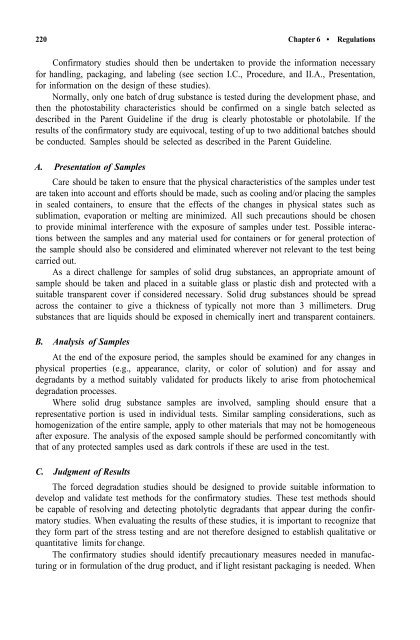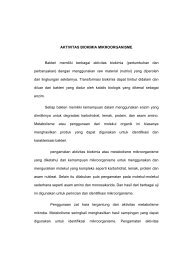Stability of Drugs and Dosage Forms Sumie Yoshioka
Stability of Drugs and Dosage Forms Sumie Yoshioka
Stability of Drugs and Dosage Forms Sumie Yoshioka
Create successful ePaper yourself
Turn your PDF publications into a flip-book with our unique Google optimized e-Paper software.
220 Chapter 6 • Regulations<br />
Confirmatory studies should then be undertaken to provide the information necessary<br />
for h<strong>and</strong>ling, packaging, <strong>and</strong> labeling (see section I.C., Procedure, <strong>and</strong> II.A., Presentation,<br />
for information on the design <strong>of</strong> these studies).<br />
Normally, only one batch <strong>of</strong> drug substance is tested during the development phase, <strong>and</strong><br />
then the photostability characteristics should be confirmed on a single batch selected as<br />
described in the Parent Guideline if the drug is clearly photostable or photolabile. If the<br />
results <strong>of</strong> the confirmatory study are equivocal, testing <strong>of</strong> up to two additional batches should<br />
be conducted. Samples should be selected as described in the Parent Guideline.<br />
A. Presentation <strong>of</strong> Samples<br />
Care should be taken to ensure that the physical characteristics <strong>of</strong> the samples under test<br />
are taken into account <strong>and</strong> efforts should be made, such as cooling <strong>and</strong>/or placing the samples<br />
in sealed containers, to ensure that the effects <strong>of</strong> the changes in physical states such as<br />
sublimation, evaporation or melting are minimized. All such precautions should be chosen<br />
to provide minimal interference with the exposure <strong>of</strong> samples under test. Possible interactions<br />
between the samples <strong>and</strong> any material used for containers or for general protection <strong>of</strong><br />
the sample should also be considered <strong>and</strong> eliminated wherever not relevant to the test being<br />
carried out.<br />
As a direct challenge for samples <strong>of</strong> solid drug substances, an appropriate amount <strong>of</strong><br />
sample should be taken <strong>and</strong> placed in a suitable glass or plastic dish <strong>and</strong> protected with a<br />
suitable transparent cover if considered necessary. Solid drug substances should be spread<br />
across the container to give a thickness <strong>of</strong> typically not more than 3 millimeters. Drug<br />
substances that are liquids should be exposed in chemically inert <strong>and</strong> transparent containers.<br />
B. Analysis <strong>of</strong> Samples<br />
At the end <strong>of</strong> the exposure period, the samples should be examined for any changes in<br />
physical properties (e.g., appearance, clarity, or color <strong>of</strong> solution) <strong>and</strong> for assay <strong>and</strong><br />
degradants by a method suitably validated for products likely to arise from photochemical<br />
degradation processes.<br />
Where solid drug substance samples are involved, sampling should ensure that a<br />
representative portion is used in individual tests. Similar sampling considerations, such as<br />
homogenization <strong>of</strong> the entire sample, apply to other materials that may not be homogeneous<br />
after exposure. The analysis <strong>of</strong> the exposed sample should be performed concomitantly with<br />
that <strong>of</strong> any protected samples used as dark controls if these are used in the test.<br />
C. Judgment <strong>of</strong> Results<br />
The forced degradation studies should be designed to provide suitable information to<br />
develop <strong>and</strong> validate test methods for the confirmatory studies. These test methods should<br />
be capable <strong>of</strong> resolving <strong>and</strong> detecting photolytic degradants that appear during the confirmatory<br />
studies. When evaluating the results <strong>of</strong> these studies, it is important to recognize that<br />
they form part <strong>of</strong> the stress testing <strong>and</strong> are not therefore designed to establish qualitative or<br />
quantitative limits for change.<br />
The confirmatory studies should identify precautionary measures needed in manufacturing<br />
or in formulation <strong>of</strong> the drug product, <strong>and</strong> if light resistant packaging is needed. When
















